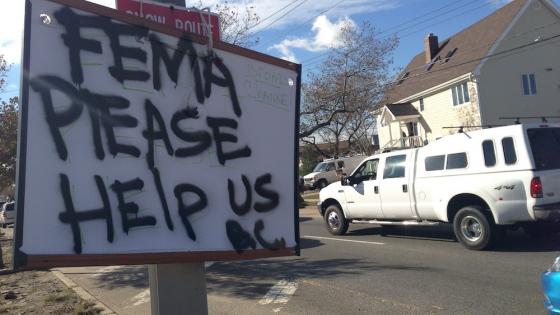Many countries provide relief funding to address the negative impact of catastrophic events on the local population and economy. In the US, the Disaster Relief Fund operated by the Federal Management Emergency Agency (FEMA) serves this purpose. Between 2001 and 2019, the US federal government provided $296 billion in disaster relief for catastrophic events.
Yet, people are not moving away from hazard-prone areas. Between 2000 and 2020, counties struck by major hurricanes experienced a remarkable population increase of 27.4%; in comparison, the continental US coastal population grew by only 14.9%.
Post-disaster programmes are a particularly salient policy matter for many political candidates when large disasters occur amid an electoral campaign. However, there is a trade-off between providing legitimate aid to affected populations and encouraging more people and capital to remain in hazardous areas.
In a recent paper (Henkel et al. 2022), we identify the impact of the electoral cycle on local post-disaster efforts and the consequences on the spatial distribution of economic activities in the US. To this end, we exploit the timing of hurricane landings relative to Election Day as an exogenous variation of natural disasters with greater electoral importance.1 Figure 1 displays the spatial distribution of hurricanes occurring less than a year before Election Day (i.e. ‘on-cycle’ hurricanes) and hurricanes occurring more than a year before Election Day (i.e. ‘off-cycle’ hurricanes).
Figure 1
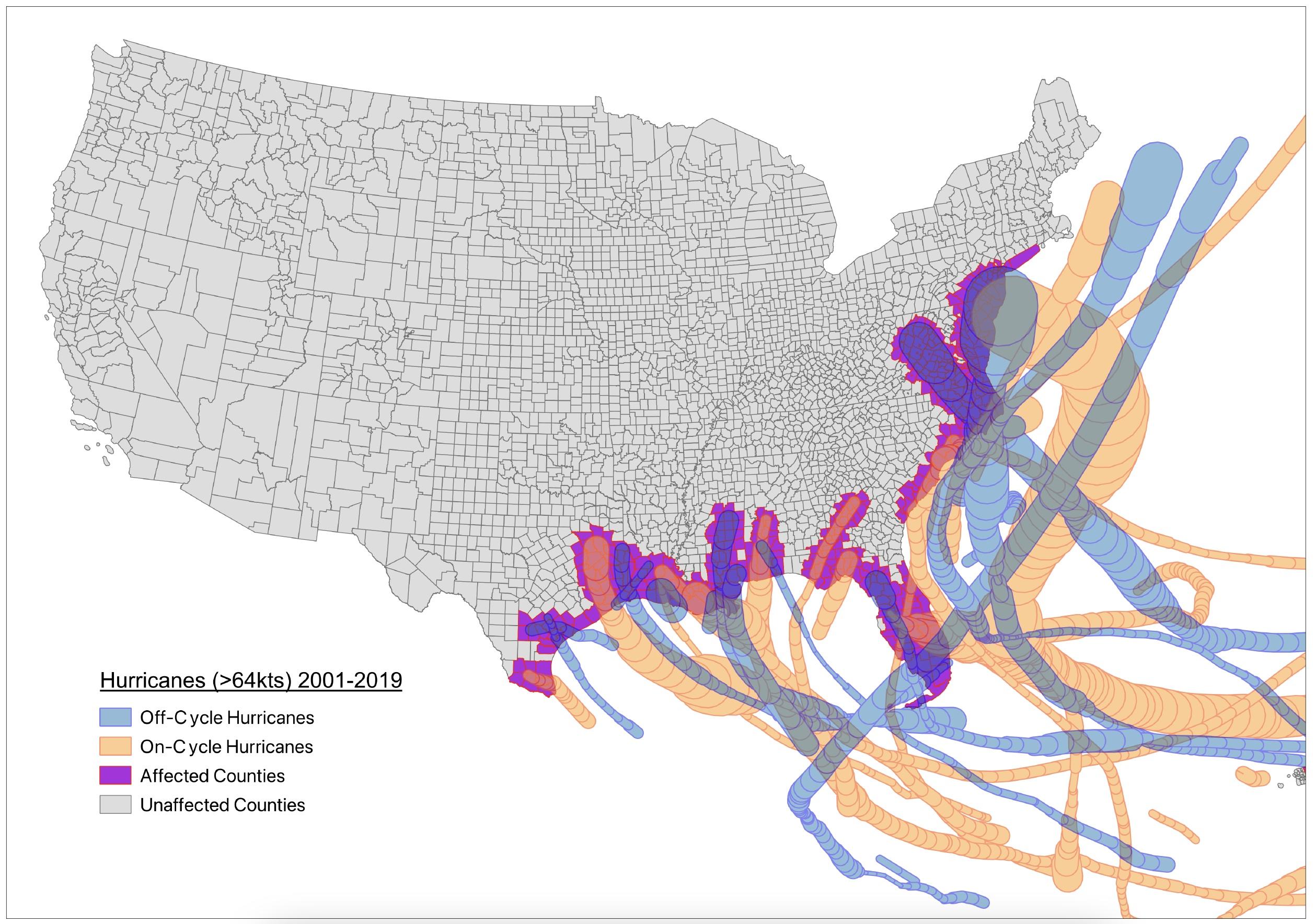
Our empirical findings using county-level data between 2001 and 2019 are as follows. We use a flexible event-study approach to analyse the local responses in counties affected by ‘on-cycle’ and ‘off-cycle’ hurricanes. In our preferred specification, we compare treated to not-yet treated units. To account for the staggered heterogeneous nature of the treatment, we use the latest estimator from the difference-in-difference literature (Callaway and Sant’Anna 2020).
First, we document that local governments spend more than they collect taxes after ‘on-cycle’ hurricanes compared to ‘off-cycle’ hurricanes. The left panel of Figure 2 shows that aggregated expenditures at the local level rose faster than collected taxes after an ‘on-cycle’ hurricane but not after an ‘off-cycle’ one. Over the post-treatment period, expenditures grew on average 2% faster than taxes, with a 4.5% increase after ten years. In sum, our estimates indicate that governments’ budgetary and post-disaster efforts depend on disaster timing.
Figure 2 Impact of on- vs off-cycle hurricanes on log net expenditures and log population
a) Effect on expenditures

b) Effect on population

At the same time, we observe that disaster timing also matters for population sorting. The right panel of Figure 2 documents that ‘on-cycle’ hurricanes lead to a significant, immediate, and long-lasting increase in population, indicating that individuals sort into affected areas after an ‘on-cycle’ disaster. In contrast, the size of the overall population remains unaffected by ‘off-cycle’ hurricanes. The results suggest that electoral incentives of post-disaster grants lead to an unintended consequence of population sorting into the affected areas.2
The impact of post-disaster policies on the spatial economy
Post-disaster policies allow areas affected by ‘on-cycle’ disasters to spend more on higher-quality public services than they otherwise could. However, all other regions have to pay for the post-disaster efforts due to the federal government’s balanced budget. Allocating resources to the areas hit by ‘on-cycle’ disasters encourages people to sort into the affected regions, as shown in Figure 2. Consequently, electoral cycles may expose a larger share of the population to natural disasters in the long run.
How much do the higher post-disaster efforts come at the expense of lower national GDP? In our counterfactual exercises, we compare the current post-disaster policies’ aggregate welfare and output effects to scenarios where electoral cycles or all post-disaster policies are removed. To quantify and comprehend the implications of this new sorting pattern for the aggregate economy, we introduce a dynamic spatial general-equilibrium model that integrates a relationship between political cycles and post-disaster policies. The model provides a simple setup to explore the role of post-disaster policies and electoral incentives in the spatial distribution of economic activity.3
We calibrate the model for the US in 2001, taking into account taxes and net transfers (including post-disaster grants) across regions, as observed in the data,4 and simulate our model forward for 80 years.5 In our first counterfactual scenario, we remove the impact of post-disaster policies driven by electoral incentives by switching off the additional effect of ‘on-cycle’ disasters. In our second counterfactual scenario, we entirely remove the impact of post-disaster programmes on transfers and endogenous amenities.
Current post-disaster policies improve welfare at the expense of aggregate GDP
The simulations reveal that a direct consequence of the current system is to push economic activity toward hazard-prone coastal areas. We show that compared to the counterfactual scenarios, the current system with post-disaster policies featuring electoral cycles increases the population in some coastal areas by up to 7% over 80 years. Figure 3 depicts ratios in local population size after 80 years in our baseline scenario, relative to our counterfactuals; switching off the effect of the electoral cycle (panel a) and post-disaster policies completely (panel b).
Figure 3 Impact of removing the electoral cycle or post-disaster policies on population sorting
a) No electoral cycle

b) No post-disaster policies
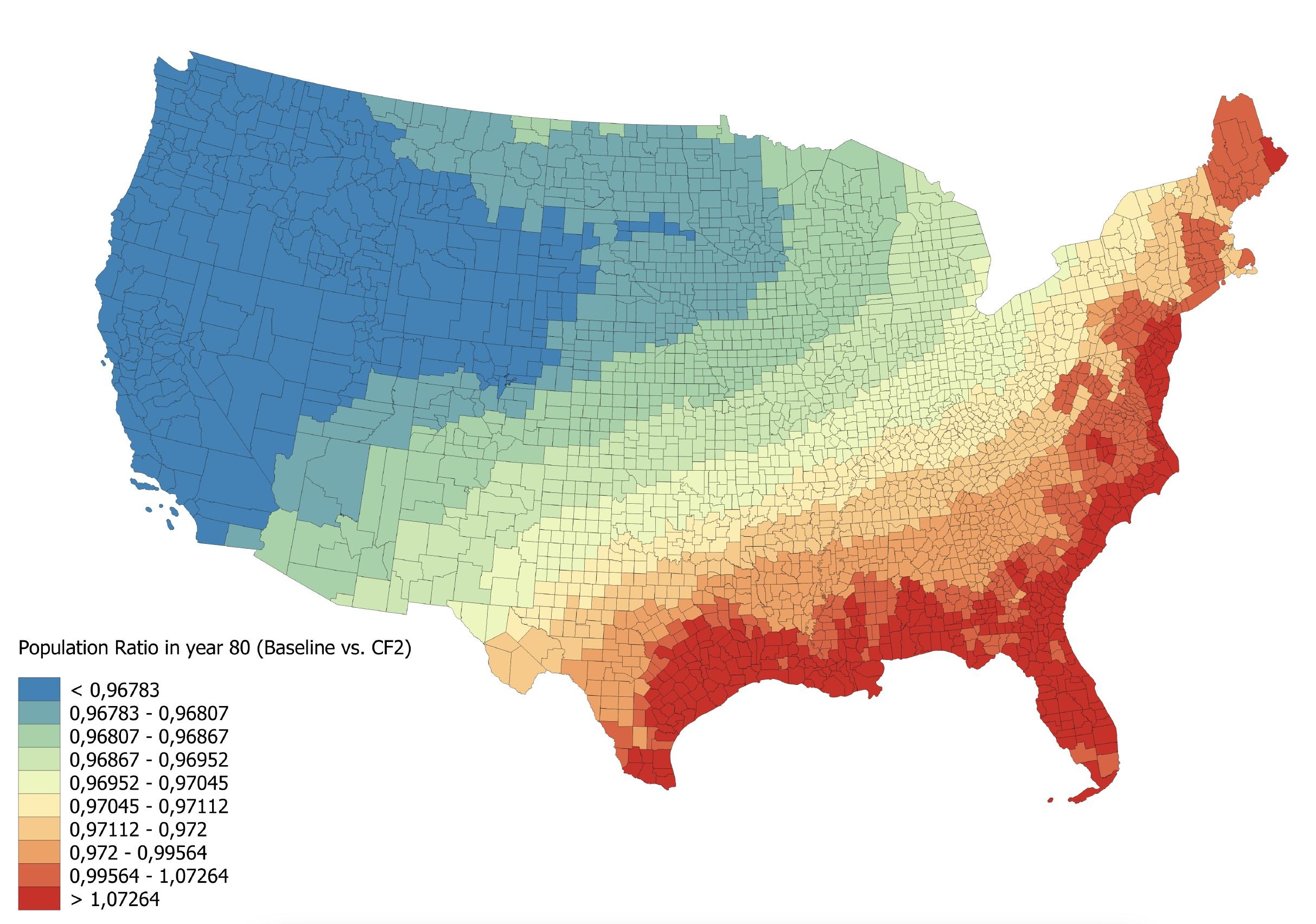
Figure 4 shows the impact of current post-disaster policies against our counterfactual scenarios for welfare (panel a) and aggregate output (panel b). Out-migration from over-congested regions and the provision of higher-quality amenities matter, such that current disaster policies improve aggregate welfare, not accounting for other disasters. Panel a of Figure 4 documents that in our baseline: welfare increases by 0.82% after 80 years relative to our first scenario and 2.10% relative to our second scenario. However, these welfare improvements come at the cost of lower aggregate productivity and real GDP at the national level (panel b).
Figure 4 Impact of removing the electoral cycle or post-disaster policies on national productivity and welfare
a) Welfare
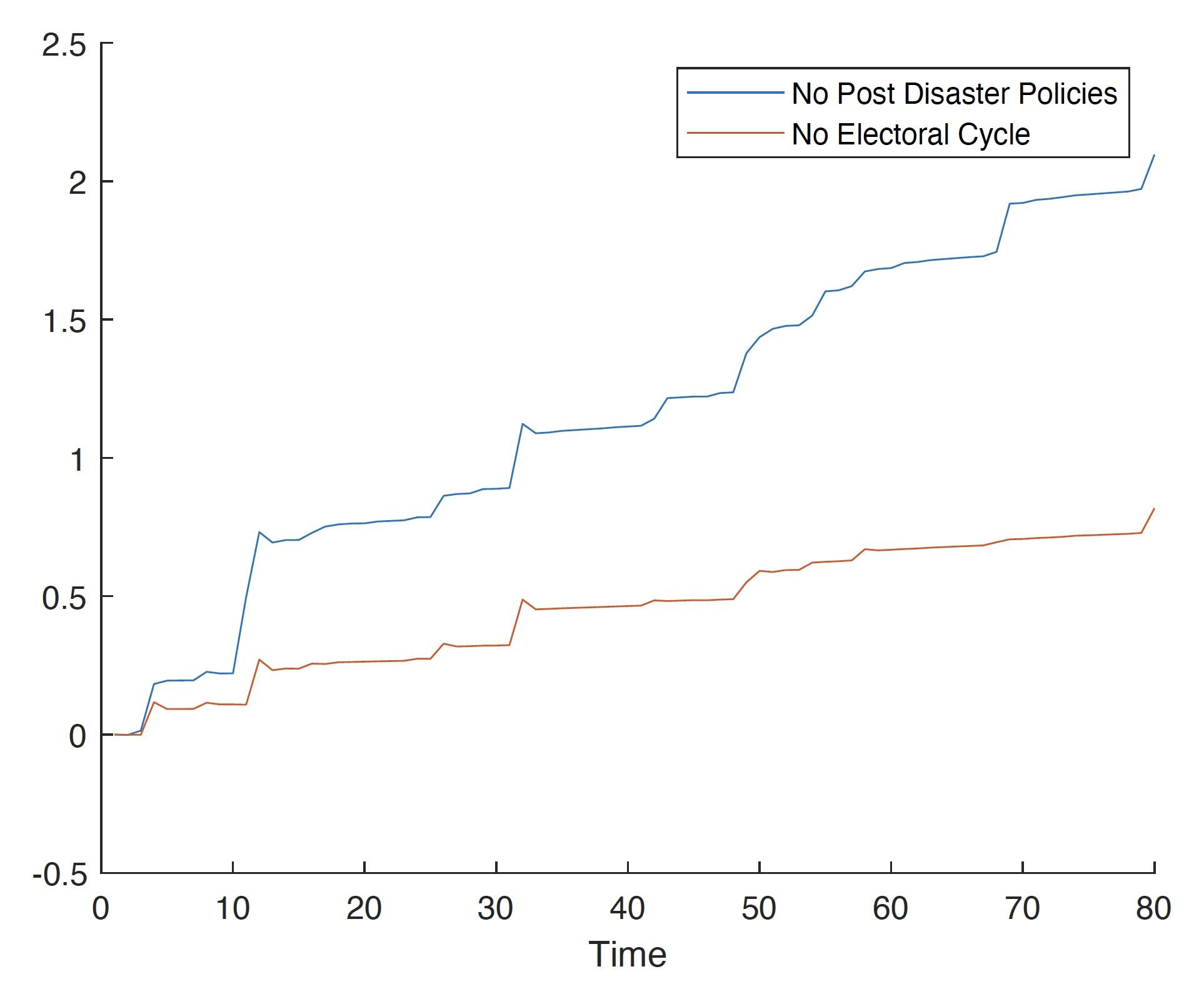
b) Real GDP
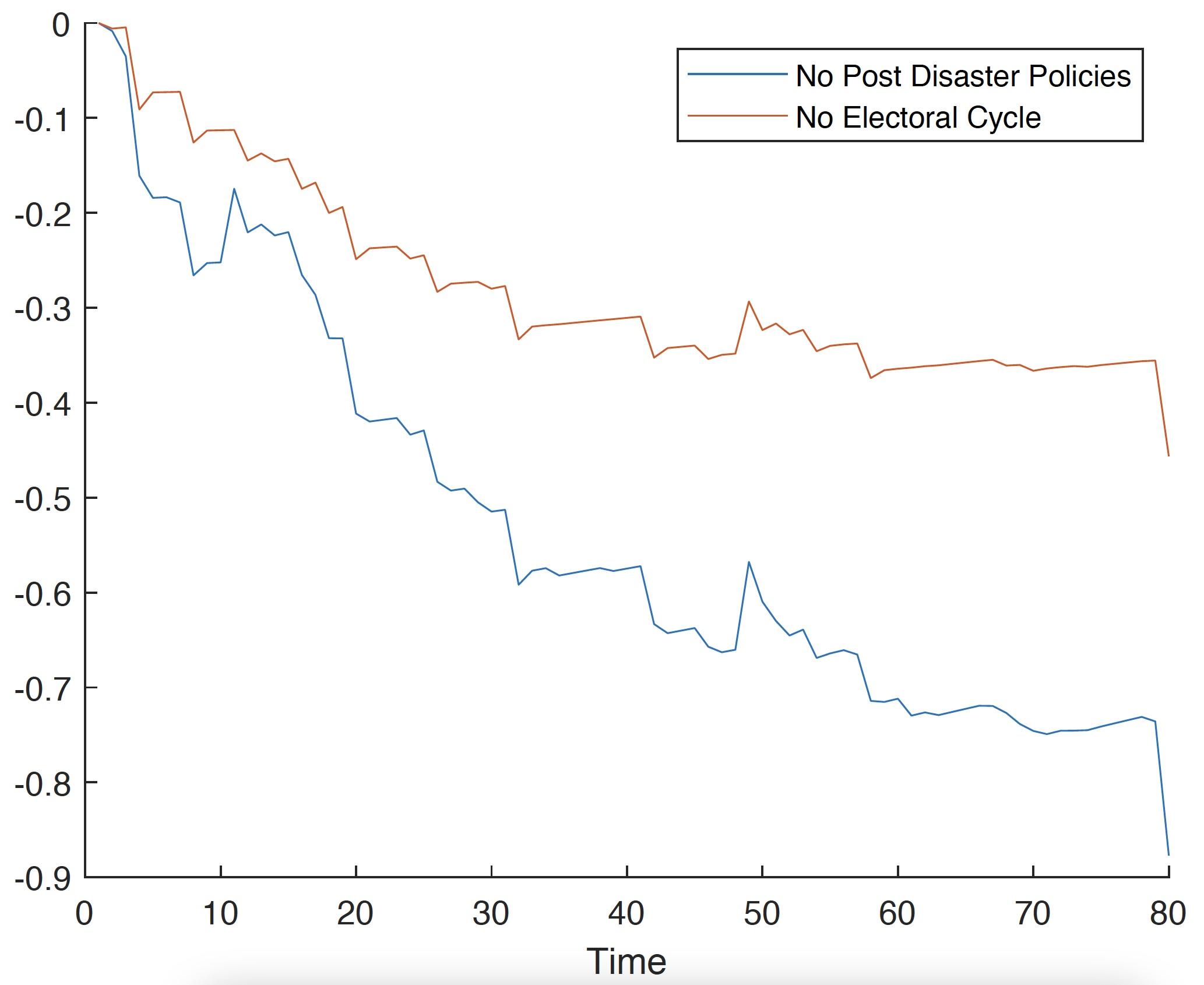
Intuitively, improvements in endogenous amenities driven by post-disaster efforts encourage the population to concentrate in coastal, amenable areas, which increases overall welfare. In turn, out-migration from over-congested regions spared by the disasters fosters these welfare improvements. However, this sorting pattern brings about overall productivity losses due to this out-migration from the most productive cities, resulting in aggregate output loss. Accounting for other consequences of climate change such as sea-level rise (Kocornik-Mina et al. 2016, Desmet et al. 2018b) would likely mitigate the welfare impact of the post-disaster efforts due to the cost of being exposed to other disasters.
Our results uncover the unintended consequences of post-disaster policies. Current post-disaster policies push economic activity towards hazard-prone coastal areas. In times of climate change and increasing disaster risk, policymakers should be aware that current post-disaster programmes might be costly because of the complex spatial responses they cause.
References
Callaway, B, and P H Sant'Anna (2020), “Difference-in-differences with multiple time periods”, Journal of Econometrics 225(2): 200–30.
Desmet, K, R E Kopp, S A Kulp, D K Nagy, M Oppenheimer, E Rossi-Hansberg and B H Strauss (2021), “Evaluating the economic cost of coastal flooding”, American Economic Journal: Macroeconomics 13(2): 444–86.
Desmet, K, D K Nagy and E Rossi-Hansberg (2018a), “The geography of development”, Journal of Political Economy 126(3): 903–83.
Desmet, K, D K Nagy and E Rossi-Hansberg (2018b), “Adapt or be flooded”, VoxEU.org, 2 October.
Emanuel, K (2011), “Global warming effects on us hurricane damage”, Weather, Climate, and Society 3(4): 261–68.
Henkel, M, E Kwon and P Magontier (2022), “The unintended consequences of post-disaster policies for spatial sorting”, CRED Research Paper No. 37, Universität Bern, Department Volkswirtschaft - CRED.
Henkel, M, T Seidel and J Suedekum (2021), “Fiscal transfers in the spatial economy”, American Economic Journal: Economic Policy 13(4): 433–68.
Knutson, T, S J Camargo, J C Chan, K Emanuel, C-H Ho, J Kossin, M Mohapatra, M Satoh, M Sugi, K Walsh et al. (2020), “Tropical cyclones and climate change assessment: Part ii: Projected response to anthropogenic warming”, Bulletin of the American Meteorological Society 101(3): E303–E322.
Kocornik-Mina, A, T McDermott, G Michaels and F Rauch (2016), “Do floods shift economic activity to safer areas?”, VoxEU.org, 21 January.
Endnotes
1 Election Day takes place on the first Tuesday of November every two years and corresponds to the general elections of most federal offices. The US presidential elections are held on that day every four years, and the US Congress elections every two years. Hurricane season occurs each year between June and late October and is therefore a salient electoral matter every other year. Additionally, whether hurricanes’ timing is concurrent with Election Day is arguably exogenous, giving us an adequate empirical setting to leverage variation in post-disaster policy efforts.
2 Importantly, these results remain qualitatively similar when using alternative estimators or control groups, controlling for storm intensity, or considering more extended periods or other extreme natural disasters such as floods or wildfires. Using alternative political dimensions (e.g. political alignment) instead of electoral cycles supports the hypothesis that electoral incentives strongly affect spatial sorting patterns.
3In doing so, we build on Desmet et al. (2018a, 2021) but make two critical amendments by adding the decision of the public sectors (Henkel et al. 2021). First, governments in every region provide local public services, and a fiscal transfer scheme reallocates resources across jurisdictions. Second, the amount of transfers and subsequent endogenous amenities that an area receives in a given period depends on being hit by a disaster shock and the electoral cycle.
4 The initial situation in our model represents a spatial equilibrium in the sense that utility is equalised across space, and individuals, who are allowed to have idiosyncratic locational preferences, have no incentives to move anymore.
5 We use a ‘short’ simulation period to acknowledge the difficulty of simulating the far future fundamental amenity distribution and the subsequent adaptation scenarios. We are also unsure about the design of prospective political and electoral institutions. Finally, according to recent climate change scenarios, the frequency and intensity of future hurricanes are unlikely to change drastically for at least 50 to 100 years in the North-Atlantic basin and are still subject to discussion among meteorologists and climate scientists (Emanuel 2011, Knutson et al. 2020).
